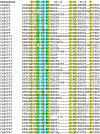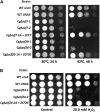Phenotypic analysis of a family of transcriptional regulators, the zinc cluster proteins, in the human fungal pathogen Candida glabrata
- PMID: 24657903
- PMCID: PMC4025492
- DOI: 10.1534/g3.113.010199
Phenotypic analysis of a family of transcriptional regulators, the zinc cluster proteins, in the human fungal pathogen Candida glabrata
Abstract
Candida glabrata is the second most important human fungal pathogen. Despite its formal name, C. glabrata is in fact more closely related to the nonpathogenic budding yeast Saccharomyces cerevisiae. However, less is known about the biology of this pathogen. Zinc cluster proteins form a large family of transcriptional regulators involved in the regulation of numerous processes such as the control of the metabolism of sugars, amino acids, fatty acids, as well as drug resistance. The C. glabrata genome encodes 41 known or putative zinc cluster proteins, and the majority of them are uncharacterized. We have generated a panel of strains carrying individual deletions of zinc cluster genes. Using a novel approach relying on tetracycline for conditional expression in C. glabrata at the translational level, we show that only two zinc cluster genes are essential. We have performed phenotypic analysis of nonessential zinc cluster genes. Our results show that two deletion strains are thermosensitive whereas two strains are sensitive to caffeine, an inhibitor of the target of rapamycin pathway. Increased salt tolerance has been observed for eight deletion strains, whereas one strain showed reduced tolerance to salt. We have also identified a number of strains with increased susceptibility to the antifungal drugs fluconazole and ketoconazole. Interestingly, one deletion strain showed decreased susceptibility to the antifungal micafungin. In summary, we have assigned phenotypes to more than half of the zinc cluster genes in C. glabrata. Our study provides a resource that will be useful to better understand the biological role of these transcription factors.
Keywords: Candida glabrata; drug resistance; phenotypic analysis; transcriptional regulators; zinc cluster proteins.
Copyright © 2014 Klimova et al.
Figures








Similar articles
-
STB5 is a negative regulator of azole resistance in Candida glabrata.Antimicrob Agents Chemother. 2013 Feb;57(2):959-67. doi: 10.1128/AAC.01278-12. Epub 2012 Dec 10. Antimicrob Agents Chemother. 2013. PMID: 23229483 Free PMC article.
-
Loss-of-Function ROX1 Mutations Suppress the Fluconazole Susceptibility of upc2AΔ Mutation in Candida glabrata, Implicating Additional Positive Regulators of Ergosterol Biosynthesis.mSphere. 2021 Dec 22;6(6):e0083021. doi: 10.1128/msphere.00830-21. Epub 2021 Dec 22. mSphere. 2021. PMID: 34935446 Free PMC article.
-
Impact of the Major Candida glabrata Triazole Resistance Determinants on the Activity of the Novel Investigational Tetrazoles VT-1598 and VT-1161.Antimicrob Agents Chemother. 2019 Sep 23;63(10):e01304-19. doi: 10.1128/AAC.01304-19. Print 2019 Oct. Antimicrob Agents Chemother. 2019. PMID: 31383660 Free PMC article.
-
Candida and candidaemia. Susceptibility and epidemiology.Dan Med J. 2013 Nov;60(11):B4698. Dan Med J. 2013. PMID: 24192246 Review.
-
Comparison of fks gene mutations and minimum inhibitory concentrations for the detection of Candida glabrata resistance to micafungin: A systematic review and meta-analysis.Mycoses. 2019 Sep;62(9):835-846. doi: 10.1111/myc.12929. Epub 2019 Jun 9. Mycoses. 2019. PMID: 31077631
Cited by
-
Candida glabrata maintains two HAP1 ohnologs, HAP1A and HAP1B, for distinct roles in ergosterol gene regulation to mediate sterol homeostasis under azole and hypoxic conditions.mSphere. 2024 Nov 21;9(11):e0052424. doi: 10.1128/msphere.00524-24. Epub 2024 Oct 23. mSphere. 2024. PMID: 39440948 Free PMC article.
-
Multiple genome analysis of Candida glabrata clinical isolates renders new insights into genetic diversity and drug resistance determinants.Microb Cell. 2022 Oct 13;9(11):174-189. doi: 10.15698/mic2022.11.786. eCollection 2022 Nov 7. Microb Cell. 2022. PMID: 36448018 Free PMC article.
-
Transcription factors Asg1p and Hal9p regulate pH homeostasis in Candida glabrata.Front Microbiol. 2015 Aug 18;6:843. doi: 10.3389/fmicb.2015.00843. eCollection 2015. Front Microbiol. 2015. PMID: 26347728 Free PMC article.
-
Current progress on pathogenicity-related transcription factors in Fusarium oxysporum.Mol Plant Pathol. 2021 Jul;22(7):882-895. doi: 10.1111/mpp.13068. Epub 2021 May 9. Mol Plant Pathol. 2021. PMID: 33969616 Free PMC article. Review.
-
Regulation of meiotic gene expression is functional in the human fungal pathogen Candida glabrata.FEMS Yeast Res. 2025 Jan 30;25:foaf018. doi: 10.1093/femsyr/foaf018. FEMS Yeast Res. 2025. PMID: 40175304 Free PMC article.
References
-
- Adams A., Gottschling D. E., Stearns T., 1997. Methods in Yeast Genetics. Cold Spring Harbor Laboratory Press, Cold Spring Harbor, NY
-
- Akache B., Turcotte B., 2002. New regulators of drug sensitivity in the family of yeast zinc cluster proteins. J. Biol. Chem. 277: 21254–21260 - PubMed
-
- Akache B., MacPherson S., Sylvain M. A., Turcotte B., 2004. Complex interplay among regulators of drug resistance genes in Saccharomyces cerevisiae. J. Biol. Chem. 279: 27855–27860 - PubMed
-
- Berila N., Borecka S., Dzugasova V., Bojnansky J., Subik J., 2009. Mutations in the CgPDR1 and CgERG11 genes in azole-resistant Candida glabrata clinical isolates from Slovakia. Int. J. Antimicrob. Agents 33: 574–578 - PubMed
-
- Bhat P. J., Murthy T. V., 2001. Transcriptional control of the GAL/MEL regulon of yeast Saccharomyces cerevisiae: mechanism of galactose-mediated signal transduction. Mol. Microbiol. 40: 1059–1066 - PubMed
Publication types
MeSH terms
Substances
Grants and funding
LinkOut - more resources
Full Text Sources
Other Literature Sources
Molecular Biology Databases
